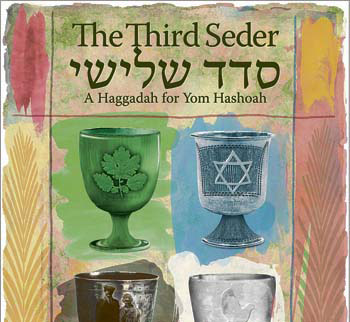MONTREAL — Many Jews remember the Holocaust at their Passover seders. Few, however, have held a seder specifically for Yom Hashoah. Some might even wonder if it is appropriate.
Yehudi Lindeman, a child survivor of the Holocaust, and Irene Lilienheim Angelico, a child of survivors, hope to change that. They have created a guide to a new ritual that is an uplifting commemoration.
They are co-authors of The Third Seder: A Haggadah for Yom Hashoah (Véhicule Press), which will be launched April 22 at Temple Emanu-El-Beth Sholom.
Lindeman and Angelico have taken their cue from Elie Wiesel, who said that after the Holocaust, Jews must start all over again by writing a new Talmud, as was done after the destruction of the Second Temple.
A new Haggadah was challenge enough for the two friends, and fitting, they believe. They hope this type of observance of the Shoah will become as engrained in Jewish tradition as the Passover seder has for more than 2,000 years.
Their Haggadah, they say, “reflects the beginning of a Jewish awakening in the aftermath of the Holocaust derived from a longing for renewal and tikkun olam. They’ve been fine-tuning it for many years.
“We hope that The Third Seder will find its place within our Jewish tradition, to live on for generations, so that we will never forget and so that a Holocaust will never happen again.”
Lindeman, a retired McGill University professor, is the founder and past director of Living Testimonies, the university’s Holocaust video archive. He is also a co-founder of the World Federation of Jewish Child Survivors of the Holocaust.
Born in 1938 in Holland, he was separated from his family and spent more than two years in hiding in about 15 different locations.
Angelico, a veteran documentary filmmaker, broke new ground three decades ago with Dark Lullabies, in which she explored the experiences of the second generation. Her parents, from Warsaw, survived a series of camps.
“The Third Seder commemorates our liberation from the Holocaust,” they write in the introduction, “echoing Passover’s celebration of liberation.”
The 27th day of Nissan on the Jewish calendar (April 19 this year) was inaugurated by the Israeli Knesset as Holocaust Remembrance Day in 1951.
The co-authors think that many Jews are looking for meaningful ways to commemorate the day in a more intimate setting than the usual large public gatherings.
Their Haggadah is meant to be used at home, at school, in congregations or at other smaller community gatherings.
This seder is participatory, egalitarian and inclusive, suitable for Christian, interfaith and secular groups. It includes historic and contemporary texts, poetry and stories.
There are places for reflection on present-day oppression and intolerance. “To acknowledge the suffering of others” is fundamental.
As at Passover, this seder is organized around the four cups. The first is a toast to spring and the new beginning it symbolizes, the second, to the freedom of the Jewish People, the third to those who perished and those who survived and rebuilt their lives, and the final one is drunk to “love and peace for all humanity.”
Lindeman and Angelico have created new symbols as well. These include six yellow tulips for the six million (yellow because it was the colour of the star Jews were forced to wear), a flowering branch to represent Jewish life before the war and its continuity today, and seeds for rebirth.
The matzah is raised but not eaten, because coarse bread is the main sustenance, a reminder that most Jews did not have matzah during the Holocaust. A full meal is not recommended, just nuts, seeds and dried fruits.
At the heart of the seder, which takes about two hours, the lights are dimmed and each participant passes a flame of hope to their neighbour, until every candle in the group is lit. The last person lights the six memorial candles.
Then Ani Ma’amin is sung and Kaddish recited.
Music and songs in Hebrew, Yiddish, and English, are important components, and include old folk and spiritual tunes and a few original works. Printed musical scores and a CD are included.
“This Haggadah… is inspired by those who died and those who survived, and by their many expressions of courage and resistance – from teaching Torah and mathematics in secret, from writing poems and songs of resistance, to rising up in the Warsaw Ghetto, the forests near Vilna, and many other places throughout occupied Europe,” the introduction reads.
The foreword by American Rabbi Arthur Waskow, a leader of the Jewish Renewal movement and longtime political activist, applauds the authors for avoiding the pitfalls that might turn Holocaust remembrance into ritual.
There would be danger if the seder was simply a re-enactment of the Holocaust and not a means of healing and teaching, he writes.
“After staring death in the face,” he advises the best one can do is “sing, dance, laugh, eat, share, love. No merely political triumph is enough to encode that kind of life-filled victory.”
The 56-page Haggadah is colourfully illustrated throughout by original coloured paintings by J.W. Stewart and the calligraphy of Susan Leviton.
On April 22 at the temple, the program begins with a book signing at 1:30 p.m., followed by the seder at 2:30 p.m., hosted by Lindeman and Angelico and accompanied by musicians and singers. Co-sponsors include the Montreal Holocaust Memorial Centre and Child Survivors/Hidden Children of the Holocaust, Montreal Chapter.
For reservations, e-mail [email protected].
